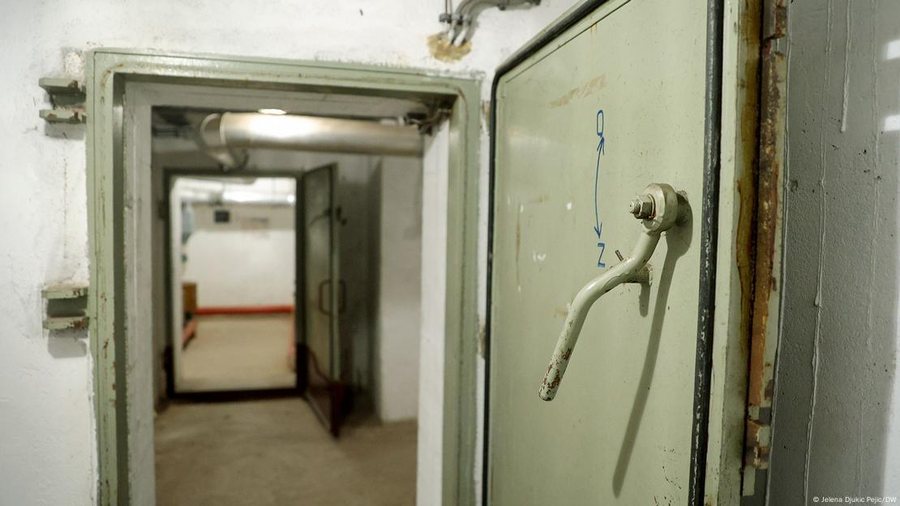
Heavy iron doors lead to large corridors underground, under the city market building in the center of Nish. Exercises are held here as in the gym, which has been open for years. But this place is actually a public shelter, currently used as a fitness center. This is one of the five shelters in Nis. Others have been converted into warehouses.
Shelters are often rented out for video games, children's birthday parties, music studios, storage of humanitarian goods, archives and other activities, writes DW.
Lack of budget for shelters
There are a total of 53 shelters in the jurisdiction of the company for the administration of shelters in Nis, and the branch of Nis also includes Krushevci, Bori, Negotini, Zajeçari, Knjazhevci, Piroti, Leskovci, Vranja, Trsteniku and Prokuplja. There are 109 shelters in all these places.
While Novi Sad alone has 158 shelters, Çaçak 25, while Belgrade has 980 shelters. In all the cities of Serbia, 1442 public shelters are under the auspices of a public company, reports A2.
Dragan Popovic, manager of shelters in Nis, also shows us a shelter for cases of nuclear attacks, which is located in the center of Nis. There are also beds here. "There is also a water supply installation, there are dry toilets. There are barrels for garbage and clean water, which are designed for a three-day supply," Popovic told DW.
"There are hydrants for extinguishing fires, there is also a room with fresh air equipment in the shelter. The air comes from outside and is filtered. It can also be done manually in case of a power cut, because we also have hand generators here." explains our interlocutor and adds that this public company is completely self-financing.
"Since 2011, we have had no subsidy from the government since the obligation to pay fees for construction and maintenance was removed. The obligation of investors to build the shelter was also removed," he says.
Lack of shelters
Since a large shelter can accommodate 300 people, the question arises whether this is enough to house the population. Officially the authorities say they are unable to answer all our questions. But at the end of November, due to the war between Russia and Ukraine, the president of Serbia, Aleksandar Vucic, declared that Serbia is completely unprepared in case of an atomic war with 257,000 people in shelters.
He then said that for years there has been no investment in shelters and that this is a mistake that must be corrected. His statement has caused different opinions. A resident of Nis says that he does not believe in the possibility of a nuclear war and that Vucic with this statement is only trying to divert public attention from other problems in the country.
"It's all over the top," says another. Building new shelters in Serbia is pure nonsense. We need to develop civil defense, because the shelters were not used even during 1999 and the NATO bombings. Besides, if a nuclear war breaks out, the shelters won't help us either."
A young man, who was born at the time of the bombings, explains that he could not even imagine what it is like to be in a shelter. He adds that he would not stay there. On the other hand, an elderly lady says that the arrangement of shelters is a great move and that Serbia should be ready for all situations.
In addition to shelters belonging to public companies, there are also shelters belonging to others, but there are only a few and they have mostly been converted into warehouses. There are also shelters in former factories that have been privatized. But the Ministry of Construction, Transport and Infrastructure told DW that they do not have information on the number of shelters inside residential buildings.
Everything depends on money, and money depends on analysis
Building new shelters and refurbishing old ones costs a lot. The last time Serbia was active in building shelters was in the early nineties, during the wars in the former Yugoslavia. But for changes in these areas, the Law on Disaster Risk Reduction and Emergency Management should also be amended. This means that all the shelters that are now decentralized management would come under the administration of the new civil protection agency. This agency, according to experts, can then transparently buy everything it needs - from sleeping bags to air purifiers.
During the bombing, numerous underground areas were used as shelters - such as cellars and other facilities. "Nuclear shelters have a clear degree of radiation protection. They were purpose-built in Serbia during the Cold War and were made of concrete over a meter thick and then coated with radiation shielding." But Serbia still has few shelters to shelter everyone in case of need./ DW (A2 Televizion)











